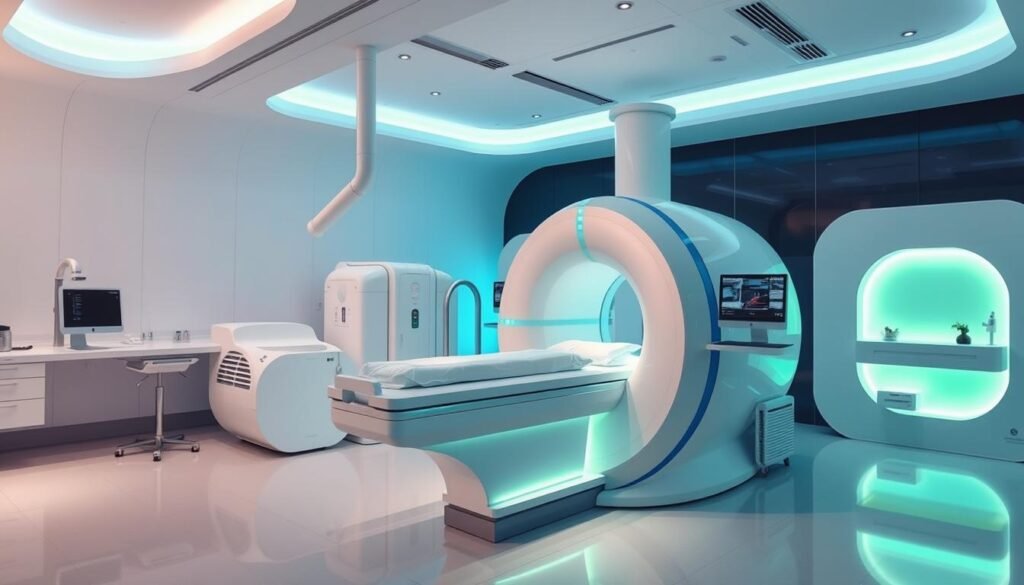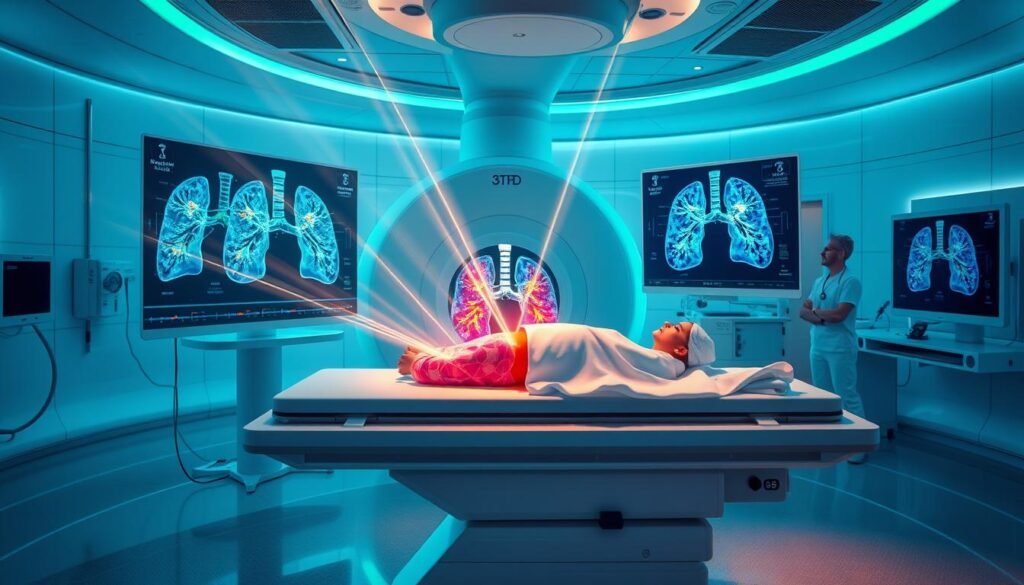Did you know proton therapy is better than traditional treatments for some lung cancers? Millions are affected by lung cancer every year. This innovative option is getting a lot of attention. Proton therapy can target cancer in the lungs without harming nearby healthy tissues. This guide explains how proton therapy works, its benefits, and its role in fighting lung cancer. It helps patients and caregivers make informed healthcare decisions.
Key Takeaways
- Proton therapy offers a specialized approach for metastatic lung cancer.
- Targeted cancer therapy aims to minimize damage to healthy tissues.
- Research indicates that proton therapy can reduce pneumonitis rates.
- Advanced technology has improved outcomes in NSCLC treatments.
- Access to proton therapy may vary based on insurance and treatment centers.
Understanding Lung Cancer and Its Stages
Lung cancer is a big health issue, split into two main types: NSCLC and SCLC. NSCLC makes up about 85% of cases. It requires different treatment compared to SCLC, which is about 15% of cases. Knowing these types and stages is key for effective treatment, especially for stage IV lung cancer where the disease is very advanced.
Overview of Lung Cancer Types
NSCLC and SCLC treatments depend on how far the cancer has progressed. For NSCLC, treatment options change depending on the cancer stage:
- Early (Stage 1 or 2): Surgery, SBRT, chemotherapy, and immunotherapy are used.
- Locally advanced (Stage 3): Combining surgery with chemotherapy, or using radiation therapy with chemotherapy, including immunotherapy.
- Advanced (Stage 4): Options include targeted therapy, chemotherapy, immunotherapy, and palliative radiation therapy, or a mix of treatments.
For SCLC, treatment also varies by stage:
- Limited disease (Stages 1 to 3): Treatment involves chemotherapy and radiation therapy (chemoradiation), sometimes with surgery.
- Extensive disease (Stage 4): Focuses on palliative chemotherapy, possibly with immunotherapy, and palliative radiation therapy.
Importance of Staging in Treatment Decisions
The stage of lung cancer is crucial for deciding on treatment. Stage IV lung cancer patients face big challenges because their disease is very advanced. Staging shows how much the cancer has spread. This impacts the treatment plan for advanced NSCLC. At this stage, surgery might not work, highlighting the need for various therapies to manage symptoms and improve life quality.
| Lung Cancer Type | Stage | Treatment Options |
|---|---|---|
| NSCLC | Stage 1 or 2 | Surgery, SBRT, Chemotherapy, Immunotherapy |
| NSCLC | Stage 3 | Surgery with Chemotherapy, Radiation Therapy with Chemotherapy |
| NSCLC | Stage 4 | Targeted Therapy, Chemotherapy, Immunotherapy |
| SCLC | Limited (Stages 1 to 3) | Chemotherapy, Radiation Therapy |
| SCLC | Extensive (Stage 4) | Palliative Chemotherapy, Immunotherapy |
The Role of Radiation Oncology in Lung Cancer Treatment
Radiation oncology is key in fighting lung cancer. It uses advanced techniques to hit and kill cancer cells. High-energy radiation plays a big part in helping patients. Knowing how it helps is crucial for cancer care decisions.
How Radiation Therapy Works
Radiation therapy targets tumors with precise radiation doses. It stops their growth. The goal is to damage cancer cells but save healthy ones. Conventional methods like photon therapy are used. They’re effective but can harm healthy cells. This shows why we need targeted treatments in this field.
Comparison of Radiation Therapy Types
There are many types of radiation therapy. Each has its own pros and cons. Here’s a brief comparison of the main types:
| Radiation Therapy Type | Mechanism | Strengths | Limitations |
|---|---|---|---|
| Conventional Radiation Therapy | Uses X-rays to target tumors | Widely available and effective | May harm surrounding healthy tissues |
| Photon Therapy | Delivers high-energy photons | Good for targeting large tumor areas | Lower precision can lead to collateral damage |
| Proton Therapy | Uses protons for treatment | Higher precision, minimizing damage to healthy tissue | Availability may be limited in some regions |
Radiation oncology for lung cancer is growing. Studies on proton therapy’s safety and effectiveness are ongoing. They aim to reduce side effects and better help patients with non-small cell lung cancer (NSCLC).
What is Proton Therapy?
Proton therapy is an advanced form of radiation treatment that uses protons, which are positively charged particles. It targets tumors with high precision, making it different from traditional x-ray therapy. This precision helps in treating patients with metastatic lung cancer effectively.
Differences Between Proton and X-ray Therapy
X-ray therapy sends radiation through the body, affecting healthy tissues too. But proton therapy concentrates radiation to a specific depth. This is thanks to the Bragg Peak. It allows for higher doses on tumors, sparing healthy tissues. Thus, patients might face fewer side effects, making it a preferred option for various cancers.
Mechanism of Action of Proton Therapy
Proton therapy precisely targets cancer cells, sparing healthy ones. It uses protons to focus on tumor sites, improving treatment effectiveness. Techniques like intensity-modulated proton therapy even tailor the dose to the tumor’s shape and size. These advancements make proton therapy innovative, especially for metastatic lung cancer patients at risk of organ damage from traditional treatments.
Proton Therapy for Metastatic Lung Cancer
Proton therapy is a promising option for metastatic lung cancer. It offers key benefits for patients with advanced disease. It’s especially good for those who haven’t had success with other treatments or who experienced bad side effects.
Indications for Proton Therapy
This treatment works well for metastatic non-small cell lung cancer (NSCLC) that’s in stage IV. Proton therapy can handle complex cases with a customized approach. It targets the tumor effectively while protecting healthy tissues, improving life quality.
Benefits of Proton Therapy in Treating Metastatic Disease
Proton therapy reduces side effects like lung inflammation, heart issues, and scarring, compared to standard radiotherapy. Its precise beams mean less radiation hits vital organs. This targeted method helps lower complication risks and has been linked to better survival rates.
Patients receiving proton therapy often face fewer side effects, which matters a lot for lung cancer patients prone to treatment injuries. Techniques like intensity-modulated proton therapy (IMPT) make it even better. For more details, check the research findings on proton therapy for metastatic lung.
Advantages of Proton Therapy Over Conventional Treatments
Proton therapy is a standout choice for lung cancer treatment, offering clear advantages. It targets cancer cells with high precision, allowing for higher doses to tumors while protecting healthy tissues. As a result, patients often see reduced side effects compared to standard treatments.
Targeted Cancer Therapy Explained
Proton therapy is a type of targeted cancer therapy focusing precisely on the tumor. It lessens the risk to nearby vital organs. Only 11.5% of proton therapy patients experienced severe side effects, much lower than the 27.6% with traditional photon therapy. This approach improves treatment success and protects patient health.
Reduced Side Effects with Proton Therapy
Proton therapy’s benefits include more than just effective treatment. Studies show proton therapy patients have a two-thirds lower risk of serious toxicity than those getting photon therapy. This means a better quality of life during treatment, especially for those with additional health issues.
These benefits make proton therapy for metastatic lung cancer a promising choice for many. It focuses on sparing healthy tissue and treatment precision, marking a major advancement in cancer care.
Understanding Particle Beam Therapy
Particle beam therapy uses charged particles for cancer treatment. This includes proton therapy. It is very precise in targeting tumors and protects healthy tissue. Learning about it helps in managing lung cancer treatments better.
How Particle Beam Therapy Works
It works with charged particles like protons. These are sped up to high energies. Protons release energy in a specific way, making this method very focused.
Traditional therapy spreads through the body, hitting healthy tissues. Proton therapy for lung cancer is different. It aims the radiation only at the tumor. This means better control of the cancer with fewer side effects.

Applications in Lung Cancer Treatment
Proton therapy is especially good for lung cancer. It’s great at treating tumors close to vital organs. It delivers higher radiation doses to tumors safely. There are 76 particle therapy centers globally, with 25 in the US. Since 2017, over 200,000 patients have used particle therapy.
Studies show proton therapy is less toxic when used with chemotherapy. This is good news for lung cancer patients. To learn more, check proton therapy principles and the effects of radiation oncology in lung.
Components of Advanced NSCLC Treatment
Treating advanced non-small cell lung cancer (NSCLC) needs a well-rounded plan. Doctors use a mix of treatments that are best for each patient. Working together in this way helps beat cancer better and lessens risks from treatment.
Multi-Modal Approach to Treatment
Treatment often involves surgery, chemotherapy, and radiation. Each one plays a key part in fighting NSCLC. They work together to reduce tumors, kill cancer cells, and boost the success of the treatment.
After treatments like chemoradiation, the cancer might still come back 50% of the time. Adding proton therapy offers new hope in overcoming these odds. It makes the approach more effective.
The Role of Chemotherapy in Combination with Proton Therapy
Chemotherapy is vital in treating advanced NSCLC. It’s even better when used with proton therapy. Proton therapy targets just the tumor, keeping healthy tissue safe. Studies show this duo improves survival chances, makes treatment easier to handle, and controls the cancer well. It might also lessen side effects.
| Component | Description | Benefits |
|---|---|---|
| Chemotherapy | Systemic treatment using drugs to kill cancer cells. | Effective against widespread disease; enhances overall treatment outcome. |
| Proton Therapy | Targeted radiation therapy that focuses on tumors while sparing healthy tissue. | Reduces toxicity; allows for dose escalation without increasing side effects. |
| Surgery | Procedure to remove the tumor and surrounding tissue. | Can provide a definitive treatment option for localized cancers. |
Chemotherapy, proton therapy, and other treatments are key for fighting advanced NSCLC. This growing plan offers hope for a better life for those dealing with this tough condition.
Precision Radiotherapy and Treatment Planning
Precision radiotherapy is a big step forward in treating metastatic lung cancer. It focuses on making treatment plans that fit each patient’s needs. By looking at tumor characteristics and patient profiles, doctors aim to improve results while reducing side effects.
Customization of Treatment Plans for Patients
Every case of lung cancer is different, requiring a tailored treatment plan. Technologies like radiomics and dosiomics are key in this process. They let doctors use advanced data analytics in their planning.
These methods help professionals create specific plans. These plans consider tumor biology variations. This leads to better management of lung cancer.
Utilization of Imaging Technologies in Proton Therapy
Imaging technologies help locate tumors accurately, which is vital for proton therapy. CT and PET scans are used for tumor characterization and to check how well treatment is working. They also help predict treatment outcomes.
These imaging tools play a big role in planning treatment. They ensure the tumor is accurately outlined. This minimizes risk to healthy tissue around the tumor.

| Imaging Technology | Purpose | Benefits |
|---|---|---|
| CT Scans | Tumor localization and volume measurement | High-resolution images for accurate planning |
| PET Scans | Identifying metabolic activity | Enhanced detection of malignant tissues |
| Radiomics | Extraction of features for treatment optimization | Predictive modeling for treatment outcomes |
| Dosiomics | Assessment of dose distributions | Improved dose escalation strategies |
This approach makes sure treatment plans can change as needed. It reflects updates in clinical scenarios and technology. This leads to better care for patients and improved outcomes. Advanced imaging and precision therapy are shaping the future of proton therapy for lung cancer.
Patient Experience with Proton Therapy
The journey through proton therapy is supportive and well-organized. It makes each patient’s experience both informative and enriching. Patients find a treatment environment that values their comfort most. They can easily voice concerns and grasp the treatment expectations at all times.
What to Expect During Treatment
Patients start with a detailed consultation to plan their treatment. Proton therapy’s cutting-edge technology, like pencil-beam scanning, pinpoints tumors with great accuracy. This method shields surrounding healthy tissues, like the heart, from harm. Traditional radiation may raise heart issues by 7.4 percent for every gray of radiation. But proton therapy greatly reduces this risk. It is especially beneficial for those worried about their long-term health.
Long-term Follow-Up and Monitoring
After completing treatment, ongoing follow-up is key. It helps catch any late effects and evaluate results. Healthcare teams ensure patients stay well-informed and supported during this time. This is important for those who’ve had other types of radiation before. Proton therapy offers a new possibility in such situations. According to patient experience, keeping an eye on health after treatment enhances wellbeing. It also addresses any emerging concerns.
| Aspect | Details |
|---|---|
| Initial Consultation | Comprehensive discussion of treatment options and expectations. |
| Treatment Duration | Varies from 1 to 6 weeks based on cancer stage and type. |
| Follow-Up Care | Regular monitoring for late effects and overall health. |
| Heart Risk Reduction | Lower radiation delivery reduces heart exposure and potential complications. |
| Global Usage | Over 200,000 patients have benefited from proton therapy worldwide. |
Seeking Treatment: Finding a Proton Therapy Center
Finding the right proton therapy center is essential for lung cancer patients. Because proton therapy is specialized, looking at several factors is key. The center you choose affects your treatment experience and results.
Factors to Consider When Choosing a Center
When picking a proton therapy center, patients should think about these points:
- Technology Availability: Make sure the center has the latest proton therapy tech. Techniques like pencil beam scanning are important for accurately hitting tumors.
- Staff Expertise: Search for a team with a lot of experience in both lung cancer and proton therapy.
- Facility Reputation: Check the center’s history. Look at reviews and success stories to be sure of good care.
- Clinical Trials: Looking into clinical trials can show new, advanced treatment options that might be available.
- Support Services: Confirm that there are extra help services, such as counseling and nutrition advice. This helps with all-around care.
Importance of a Multidisciplinary Care Team
A team of various specialists is vital for the best lung cancer treatment. This includes doctors from different fields working together on unique treatment plans. This covers all parts of a patient’s health.
Proton therapy places strong value on this team approach. A dedicated team caters to every patient need, making complex treatments more effective. This approach can greatly improve recovery and outcomes in lung cancer treatments.

Research and Clinical Trials in Proton Therapy
The study of cancer treatments is always improving. This is thanks to research and clinical trials on proton therapy. These efforts are critical in showing how well proton therapy works for lung cancer patients.
New outcomes from trials offer better insights. They show that proton therapy can lead to higher survival rates. It also causes less harm compared to traditional radiotherapy.
Latest Studies on Proton Therapy Effectiveness
Recent studies report over 1,200 patients joining proton therapy research. About 85% of those at proton centers take part in trials or data registries. This majorly boosts lung cancer treatment research.
Right now, adults can choose from 14 active research protocols. There are several for children too. This shows a big promise to improve proton therapy standards.
Future Directions in Lung Cancer Treatment Research
Currently, 97 proton therapy facilities are up and running globally. Another 44 are being built. This growth is key because it lets more patients access proton therapy. Right now, less than 1% of all radiation therapy patients get this top-notch treatment.
Studies have found that proton beam therapy is good for those with non–small cell lung cancer (NSCLC). It’s especially useful for those who can’t handle tough chemoradiation. Proton therapy protects vital organs like the heart and esophagus from damage.
| Statistic | Data |
|---|---|
| Patients Enrolled in Trials | Over 1,200 |
| Active Research Protocols | 14 for adults, various for children |
| Proton Therapy Facilities | 97 operational, 44 under construction |
| Patients Treated with Proton Therapy | Over 170,000 |
| Percentage of Radiation Therapy Recipients | Approximately 1% |
Proton beam therapy shows more promise in treating lung cancer. It lowers harm for some patients. Ongoing research in proton therapy aims to make lung cancer care better worldwide.
Conclusion
Proton therapy has changed the game for treating lung cancer, especially the non-small cell type. It targets the cancer with precision. This reduces harm to healthy organs like the heart and esophagus. It’s a safer choice for patients who can’t handle harsh treatments.
This therapy is great for patients with other health issues or big tumors. It has shown good results even in older patients who are at a higher health risk. These patients had survival rates similar to those who underwent traditional treatments. Proton therapy is now a key part of fighting lung cancer, helping patients without hurting their quality of life.
Research keeps showing us how valuable proton therapy can be for lung cancer patients. It’s becoming a beacon of hope for many. The way we treat lung cancer is evolving, thanks to proton therapy. It’s opening up new paths for those dealing with this tough disease.